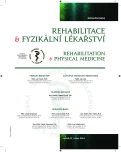Respiratory Complications in Patients after Spinal Cord Injury and their Management at the Spinal Cord Unit in University Hospital Motol
Authors:
J. Kříž; Z. Hlinková
Authors‘ workplace:
Spinální jednotka při Klinice RHB a TVL 2. LF UK a FN v Motole, Praha
přednosta prof. PaedDr. P. Kolář, Ph. D., primář MUDr. J. Kříž, Ph. D.
Published in:
Rehabil. fyz. Lék., 21, 2014, No. 1, pp. 16-20.
Category:
Original Papers
Overview
Spinal cord injury often leads to respiratory system dysfunction. With higher level lesions, the mechanics of breathing are impaired and respiratory complications may occur. Apart from the respiratory insufficiency patients often have an impaired ability to expectorate, increased risk of aspiration, atelectasis, or bronchopneumonia. Clinical observation shows a marked decrease in the compliance of the chest wall, paradoxical breathing, and also bronchial hypersecretion. Patients with cervical level lesions often undergo temporary placement of a tracheostomy tube. The timing of the removal of the tracheostomy tube is important. Active and passive respiratory physiotherapy is essential in the prevention and the management of respiratory complications.
Keywords:
spinal cord injury, respiratory complications, tracheostomy, respiratory physiotherapy
Sources
1. ALVAREZ, S. E., PETERSON, M., LUNSFORD, B. R.: Respiratory treatment of the adult patient with spinal cord injury. Phys. Ther., 61, 1981, 12, s. 1737-1745.
2. BOBATH, B.: Adult hemiplegia. Evaluation and treatment, Heinemann, London, 1990.
3. BROWN, R., DIMARCO, A. F., HOIT, J. D., GARSHICK, E.: Respiratory dysfunction and management in spinal cord injury. Respir Care, 51, 2006, 8, s. 853-868.
4. ITZKOVICH, M., GELERNTER, I., BIERING-SORENSEN, F., WEEKS, C., LARAMEE, M. T., CRAVEN, B. C. et al.: The Spinal Cord Independence Measure (SCIM) version III: reliability and validity in a multi-center international study. Disabil Rehabil., 29, 2007, 24, s. 1926-1933.
5. KANG, S. W., SHIN, J. C., PARK, C. I., MOON, J. H., RHA, D. W., CHO, D. H.: Relationship between inspiratory muscle strength and cough capacity in cervical spinal cord injured patients. Spinal Cord, 44, 2006, 4, s. 242-248.
6. KIRSHBLUM, S. C., WARING, W., BIERING-SORENSEN, F., BURNS, S. P., JOHANSEN, M., SCHMIDT-READ, M. et al.: Reference for the 2011 revision of the International standards for neurological classification of spinal cord injury. J. Spinal Cord Med., 34, 2011, 6, s. 547-554.
7. KOLÁŘ, P. et al.: Rehabilitace v klinické praxi, Galen, Praha, 2009.
8. LEMONS, V. R., WAGNER, F. C. Jr.: Respiratory complications after cervical spinal cord injury. Spine, 19, 1994, 20, s. 2315-2320.
9. MASON, R. J., BREMNER, C. G., DEMEESTER, T. R., CROOKES, P. F., PETERS, J. H., HAGEN, J. A., DEMEESTER, S. R.: Pharyngeal swallowing disorders: selection for and outcome after myotomy. Ann. Surg., 228, 1998, 4, s. 598-608.
10. NEVILLE, A. L., CROOKES, P., VELHAMOS, G. C., VLAHOS, A., THEODOROU, D., LUCAS, C. E.: Esophageal dysfunction in cervical spinal cord injury: a potentially important mechanism of aspiration. J. Trauma, 59, 2005, 4, s. 905-911.
11. PIEPMEYER, J. M., LEHMANN, K. B., LANE, J. G.: Cardiovascular instability following acute cervical spine trauma. Cent. Nerv. Syst. Trauma, 2, 1985, 3, s. 153-159.
12. REID, W.D., BROWN, J.A., KONNYU, K. J., RURAK, J. M., SAKAKIBARA, B. M.: Physiotherapy secretion removal techniques in people with spinal cord injury: a systematic review. J. Spinal Cord Med., 33, 2010, 4, s. 353-370.
13. SMOLÍKOVÁ, L., HORÁČEK, O., KOLÁŘ, P.: Plicní rehabilitace a respirační fyzioterapie. Postgraduální medicína, 3, 2001, 6, s. 522-532.
14. VISHNU SHARMA, M., ANUPAMA, N.: Assessment of diaphragm functions. pulmon., 13, 2011, 3, s. 102-107.
15. VOJTA, V., PETERS, A.: Vojtův princip, Grada publishing, Praha, 1995.
Labels
Physiotherapist, university degree Rehabilitation Sports medicineArticle was published in
Rehabilitation & Physical Medicine

2014 Issue 1
- Hope Awakens with Early Diagnosis of Parkinson's Disease Based on Skin Odor
- Deep stimulation of the globus pallidus improved clinical symptoms in a patient with refractory parkinsonism and genetic mutation
Most read in this issue
- Respiratory Complications in Patients after Spinal Cord Injury and their Management at the Spinal Cord Unit in University Hospital Motol
- Qualitative Evaluation and Testing in Patients after Lower Extremity Amputation
- A Study in Typical Changes of Peripheral Circulation during Application of Vacuum-Compression Therapy
- The Influence of Morphological Variables of the Foot on Kinematics of the Gait
